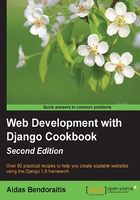
Introduction
In this chapter, we will see a few good practices when starting a new project with Django 1.8 on Python 2.7 or Python 3. Some of the tricks introduced here are the best ways to deal with the project layout, settings, and configurations. However, for some tricks, you might have to find some alternatives online or in other books about Django. Feel free to evaluate and choose the best bits and pieces for yourself while digging deep into the Django world.
I am assuming that you are already familiar with the basics of Django, Subversion and Git version control, MySQL and PostgreSQL databases, and command-line usage. Also, I am assuming that you are probably using a Unix-based operating system, such as Mac OS X or Linux. It makes more sense to develop with Django on Unix-based platforms as the websites will most likely be published on a Linux server, therefore, you can establish routines that work the same while developing as well as deploying. If you are locally working with Django on Windows, the routines are similar; however, they are not always the same.